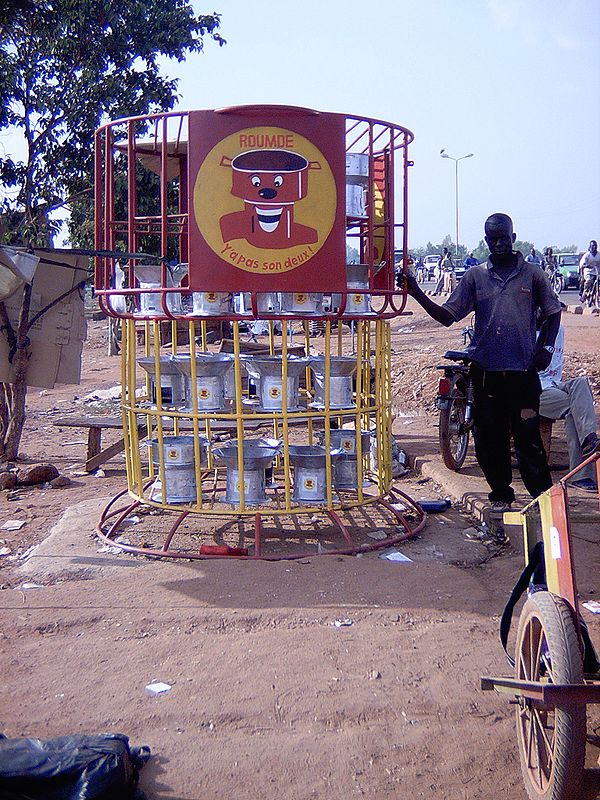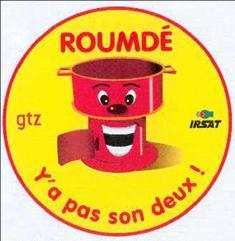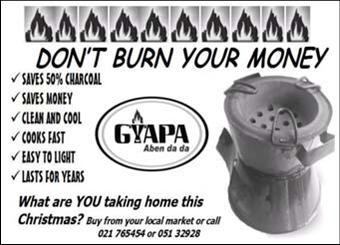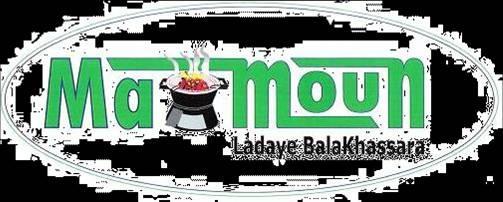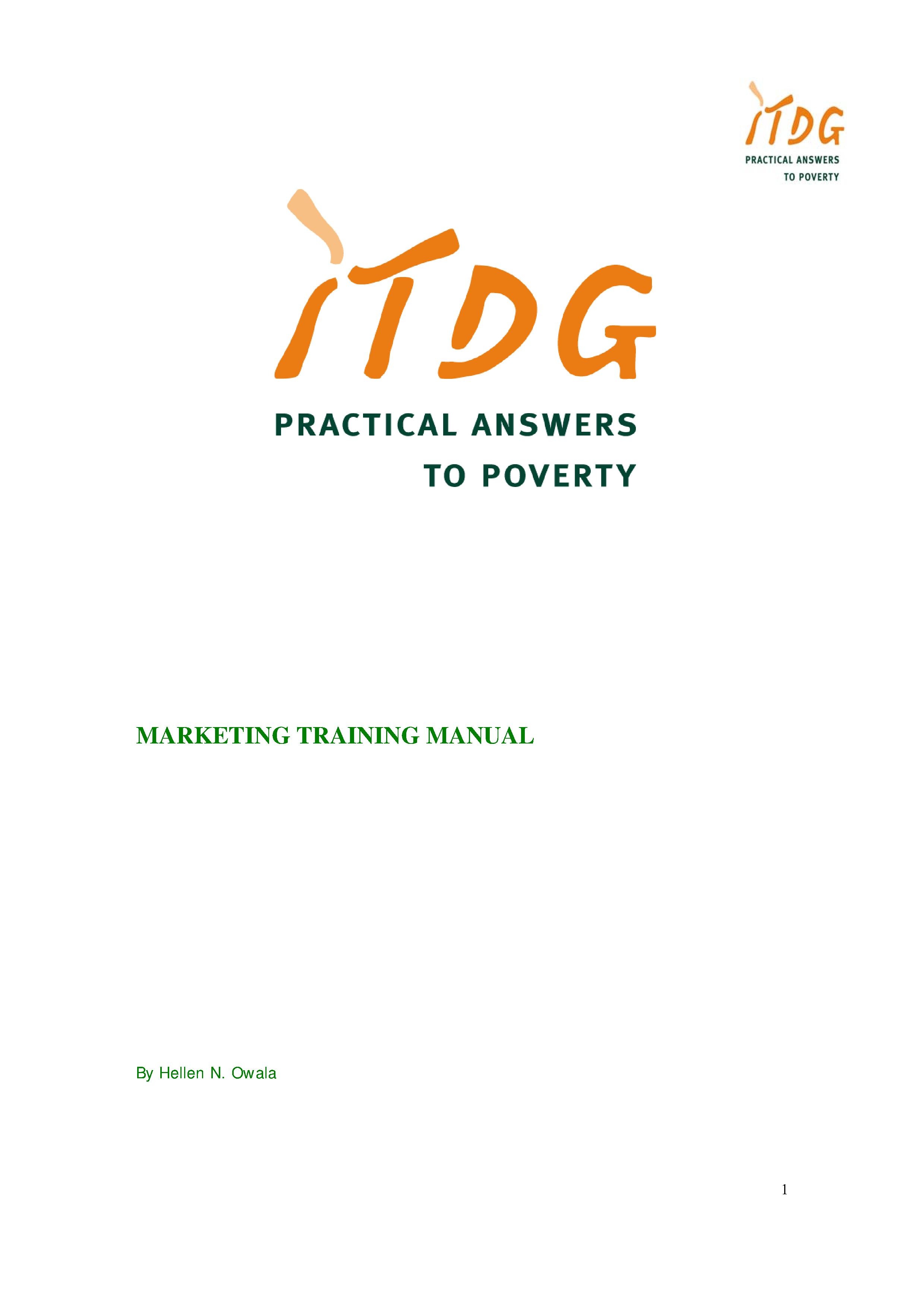Commercialisation of Cookstoves
--> Back to Overview GIZ HERA Cooking Energy Compendium
Marketing improved cooking stoves
Marketing is defined as getting the right product (in this case a stove), of the right quality to the target users in the right quantity, and at the right price in the right place at the right time and with each business person in the marketing chain making a fair profit. This calculation should not include those involved in the stove project, only those running the business.
| Product, Price, Place, and Promotion As a general rule, marketing includes all the activities that lead to increased profitable sales. The classic marketing approach involves the so called 4Ps: Product, Price, Place, and Promotion. Hence, the 4 Ps form the four main pillars of the marketing mix. These include the identification and development of new Products, at an appropriate Price, through distribution channels and selling in the right Places, supported by Promotion. Recently this number has been increased (up to 10 Ps) to include among others People, Processes, Packaging and so on. (www.wikipedia.org). However, this paper refers to the classical model of 4 Ps, because it is still the most widely used one. |
The 4 Ps: Product
This ‘P’ includes the range of products, their quality, the product design, branding, packaging and accompanying services.
These key factors should be considered:
- Design and type of improved stove has to meet customer’s needs
- Stoves need to comply with quality standards that have to be made known to the purchaser
- Improved stoves need to have a good reputation: to be known as durable and easy to handle
- Improved stoves have to be attractive for the market, thus they should have status, style, and other desirable product attributes
Product or target group first?
- Either you dispose already of a stove type (you are not free in the choice, you don’t have the possibility to develop a new stove): then you have to look for a target group that most fits to the stove you have (based on your enquiries on cooking habits and users’ motives)
- Or you have testing and developing facilities: then you can identify your target group first and look if you can get your stove fit into their ideas
The “right” stove:
- is an improved stove, i.e. it saves at least 40 % of fuel in comparison to the stove traditionally used
- meets the purchase power of the target groups
- fits into cooking habits of the users (don’t waste your time in trying to change cooking habits – it will not work)
|
Please consider: Cooking habits are composed of a multitude of elements:
|
In addition to cooking habits one has further to look both at the users’ cooking needs and at their complaints on the stoves they use. What would users prefer to change with regard to their previous stoves? How should a new stove look like compared to the old cooking device? These motives correspond not necessarily to the project’s (promoter’s) motives.
What are the project’s (promoter’s) motives to introduce an improved stove?
- Protecting the environment: the stove uses less biomass
- Fighting against climate change: the stove emits less CO2
- Fighting against indoor air pollution: the stove emits less smoke
What are possible motives for users to want to change their stoves?
- Saving money: the stove uses less fuel
- Saving time: the stove must be quicker
- Keeping the kitchen proper: the stove produces less ash
- Being less exposed to smoke: the stove emits less smoke
- Being less exposed to heat and the danger of burns: the stove is better isolated,/ the fire is shielded
- Being modern => the efficient stove might have the image of being more modern compared to the previous cooking technology
Cooking habits and user motives can change within one country according to regional and social differences. Whereas cooking habits are easily to determine, user motives are often unconscious and implicit as people often don’t even think of alternatives. To determine these factors, quantitative and qualitative marketing research is an indispensable tool.
Additional information resources
For detailed information on baseline studies, production systems, etc. see also chapters on planning and technology.
The 4 Ps: Price
Pricing of an efficient stove has to find the equivalence between
- The producer’s need to make profit (only when he makes profit he will continue production even after the end of the project). The price thus has to include all the costs associated with producing and selling the item.
- The consumer’s desire to have a cheap stove.
What “cheap” means depends on:
- The price of the traditional stove. When the traditional stove is a 3-stone-fire, the margins for an improved stove are very low: the improved stove has to compete with a stove that is for free - even if people save money on fuel while using it.
- The purchase power within the population. In least developed countries margins are much lower as in countries where a considerable middle class exists.
Getting the price right
|
When working with small scale producers in the informal sector, price calculation has to be included in the training (Benin). Producers also have to learn to convince the costumer of the necessity to buy improved stoves that are in general more expensive than the traditional one.
The 4 Ps: place
Planning the location of manufacture, sales and distribution is important:
A situation often to be found is having selling points at the same site where production takes place.
Nevertheless, the two points have to be considered separately:
The place of production:
The choice of the production place depends on:
- The availability of raw materials: locating workshops close to raw material supplies will reduce transport costs.
- The availability of technical skills: for many stove types experienced producers are needed. Even if it were possible to get producers to move to production places, manifold social and economic considerations can be an obstacle to this: e.g. in West Africa, metal work is often caste bound and members of specific castes cannot not install themselves everywhere. Neither can people who are not born into one of the appropriate castes engage in metal stove production. Or, on the other hand, ceramic stoves can only be produced where both the potters and the clay are available.
- The availability of production machines in the case of semi-artisanal and mass production.
The place of sale
The place of sales and distribution is of high importance to get the stove easily accessible, to present it to the potential user and to bring it to places where the client can easily purchase it.
Whereas in the case of portable stoves, the stove can “go” to the client, in the case of fixed stoves it’s the producer’s skill that has to be brought to the customer. For more information on these two different production systems see: selection of technology.
The commercialisation of portable stoves
In the commercialisation of portable stoves two scenarios can be found:
- The producer as seller to the client
- Sales through a retail system
These patterns have in general developed in an independent way from the existence of improved stoves, i.e. they have been in existence well before the introduction of ICS and are integrated into the general consumption patterns.
1. The producer as seller
In Burkina Faso, 90 % or more of the sales are done directly from the producer’s workshop. Whereas in the Western part of the country, the producers employ ambulant salespersons, for the most part relatives which receive a profit margin from the sales price, in other regions they simply stay in their workshops waiting for clients. Clients know “their” producer and when they need a stove, they go to see him.
This is a scenario for small scale producers who already before having been trained in producing improved stoves, produced traditional ones. In this case the producers have also to be trained in better presenting and offering their stoves and to convince the client to change to the new – and in general more expensive – one. (Albert Kéré PPT)
The case is different when new stove producers enter into the market through the project’s activities. Then, in addition, their addresses and working places have to be communicated to the public.
Generally, the stove producers have to be encouraged to make their own publicity, e.g. street bills, publicity on cars, bicycles, etc.
Strategic selling points at places where many people pass can attract much more customers than workshops that are sometimes not so easy to find.
The producer being at the same time the seller of stoves can hinder considerably the wide spread of the stoves.
In most cases this system is difficult to change, because of:
- Profound mistrust of producers to collaborate with resellers. This is mostly based on quarrels on paying moods: are the producers paid when they deliver to the reseller or when the reseller has really sold?
- The tendency of maintaining all the profits generated from the stove business within the family (most clearly in those cases where resellers are relatives).
These motivations are difficult to break up – even if it’s still worth trying. Means might be:
- Installation of a warranty fund that steps in when either the producer or the reseller faces losses due to the misappropriation of stoves.
- Creation of meeting possibilities for producers and resellers where they can discuss and resolve their disputes.
- Show rooms: In Malawi, one producer of institutional metal rocket stoves is selling off his workshop. As his workshop is in a small village 80 km away from the next bigger city, he realised quickly that he would need a show room to attract customers. He thus rented a show room at the fare compound to display his stoves.
2. Sales through a retail system
Retail systems can be found on very different levels depending on the country’s economic level and the shopping habits of its habitants:
- Supermarkets or petrol stations (chains)
- Sales points
- Kiosks
- Ambulant salespersons
- Associative structures
While working with already established producers, the project has to analyse properly where it needs to intervene to support stove sales and to boost dissemination of improved stoves. In general, the choice of the sales structure to be enforced depends on the general shopping habits of the target groups. These can best be determined by a thorough market study.
|
Points to consider:
|
Examples for boosting stove sales through commercial structures:
- Make the sales point visible: indication panels
- Make the sales point known: advertisements in journals or radios
- Make sales persons more visible and flexible: i.e. through pushcarts
Special sales points such as kiosks or energy shops can be a good idea, because they are very visible. The challenge can be that clients have to adapt their shopping habits and get used to the idea of buying stoves there.
|
Example: roumdé kiosks in Burkina Faso |
|
Example: betjek system in Senegal and ambulant sellers in Burkina Faso |
|
Example: microfinance in Burkina Faso |
The commercialisation of fixed stoves
In the case of fixed stoves
- the “sales place” represents rather the place where the constructor can be contacted and the stove can gets known.
- the producer has to go to the client for building the stove, he/she can’t remain in just one place. Depending on society this can be a barrier to women producers.
- the raw material has to be available near to the costumer homes whereas the producer has to be more mobile as in the case of portable stoves.
In the beginning, the project can support the producer or the installer in his/her efforts of getting known to potential customers.
Possible activities could be:
- The publication of lists of stove builders, e.g. in journals, through radios, as table at public places, etc.
- The installation of panels indicating where the stove builder can be found and how he can be contacted
- Passing the message through associative structures
In addition, the stove builder has to be encouraged to make his own publicity, e.g. street bills, publicity on cars, bicycles, etc.
|
Example: Kenya |
The 4 Ps: Promotion
|
What is promotion? |
A high quality, user friendly and affordable stove does not automatically translate into high volume sales. Large-scale dissemination of such a stove is much more likely to be achieved with professionally designed and implemented marketing campaigns. Promotional strategies are at the core of any product marketing.
Please note:
Whereas product marketing is focused on a specific product, awareness raising focuses on information about improved stoves in general and explains problems related to the use of traditional stoves. Means of communication can be the same in both cases.
In reality however, both product promotion and awareness raising are oftentimes interlinked: a project promoting the use of efficient stoves usually promotes several specific products while at the same time informing about the benefits of improved stoves in general.
Nevertheless, with regard to sustainable stove dissemination, it is of utmost importance that stove producers themselves engage in promotion of their products and brands. Larger campaigns or activities could be organised and financed by stove producer associations, if existing.
If a (new) stove is being promoted, the project usually will be engaged in product promotion to introduce the stove to its potential customers and to support its producers.
|
Branding and logos |
Some stove logos and their meanings:
Publicity campaigns
Before conceiving a promotion campaign two major points have to be considered:
- What does the user expect from a stove (e.g. the “user’s motive” discussion here above)?
- What does the potential future user know about improved stoves?
Many countries already have had improved stove’s campaigns in the past. Lots of people thus know in theory or in praxis about the principle and the advantages of improved stoves. In such contexts, publicity campaigns can use other arguments in comparison to contexts where people never have heard about the possibility that energy can be used in a more reasonable way. In contexts where huge dissemination campaigns had already existed in the past, it could be very helpful to know why the dissemination of stoves was not successful. Which prejudices against stoves can people have resulting from former ICS campaigns?
If you know what the potential users expect from a stove and what they already know on improved stoves you can identify key messages for the publicity campaign. Be aware that users do not necessarily have the same expectations with regards to a stove as the project! (See discussion of “users’ motives” above). In addition different groups can be interested in different messages (social differences, men – women etc.). It is more important to highlight stove economy or other issues related to the users than the global environment.
Market studies and tests can help you to identify the best messages.
The most usual messages are:
- The stove saves money!
- The stove is quick!
- The stove is proper!
- The stove emits less smoke and/or heat!
- The stove is modern!
The messages have to be well selected (not too many, only the most important ones) and should be transmitted in a most comprehensive and interesting way.
Product promotion can consist of a wide range of different activities:
- TV- and radio commercials
- Posters
- Brochures
- Participation in trade fairs and other public shows
- Organisation of specific sales shows
- Cooking demonstrations and competitions
- Theatre sketches
- Sponsoring activities
- Ads in newspapers
- Ads on bicycles, billboards, etc.
Experience has shown that:
- Publicity activities should be various and flexible.
- Strategies need to be selected and adapted to meet local conditions and the target group(s) in each locality.
- Marketing strategies should include short, memorable, crisp brand names, and eye-catching logos to raise the profile of the stove and make it a popular commodity that users are willing to purchase.
- It is helpful to using memorable slogans, and colourful images (particularly for those who do not read), to highlight key messages.
- Some promotion may need to be repeated at intervals to have a substantial impact.
- Budgets need to be subdivided for each promotional activity.
- The involvement of extension services should always be included in promotion.
|
Examples: eye-catchers: celebrities in Ethiopia – comic sketches in Burkina Faso
|
Additional information
- An example of a hierarchy of triggers for women and men to ICS purchase in India is given by Shell Foundation in an article of the Boiling Point magazine (http://www.hedon.info/BP58:ShellFoundationTheRoomtoBreatheCampaign?bl=y#Triggers_and_barriers_to_purchase)
- For developing communication strategies please see: Creation of Public Awareness for ICS
Roles and tasks in promotion: the promotion specialists – the project – the producers
High marketing professionalism - Promotion experts
Even if the identification of key messages can either be done by the project or by PR-professionals, experts are absolutely needed to translate these into a publicity campaign.
Also, the conception and realization of TV- and radio-spots is specialists work and cannot be done by amateurs. A substantial budget has to be foreseen by the project - not only for the conception, but also for a substantial number of broadcasts.
The success of your campaigns is best evaluated by a structure independent from both the project and the PR-agency, e.g. in cooperation with a university.
Furthermore, for a project it can be very helpful to engage communications designer for developing at a visual identity for the project. This ensures that all project activities, interventions and public appearances are easily recognisable to the public.
Excellent stove knowledge - the project / stove promoters
Whereas skills needed to conceive a visual identity or a TV-spot can be independent from skills in stoves and energy, people who execute promotion activities such as cooking demonstrations, sales shows etc. need to have profound knowledge on the stove, and on energy issues. In direct contact to the target group a multitude of questions and reactions comes up. Not all can be foreseen and an event specialist cannot necessarily be prepared to answer them. For this kind of activities thus stove and energy specialists are needed to be able to respond to a wide range of questions and situations.
Excellent stove knowledge - the producers
The best specialists on stoves and their technical specifications are the producers. However, they do not necessarily know much about its use (starting from the fact that many stove producers are men and most users are women).
Nevertheless, it is absolutely necessary to involve the producer in promotion activities:
- to establish a direct contact between the producers and the potential clients
- to ensure sustainability: the producers will most probably be the only permanent actors left after the end of the project.
The project should thus have a strong interest to develop the producers’ capacities in marketing and awareness rising skills and also with regard to practical questions of users (user training).
|
Example: small scale producers become event specialists in Burkina Faso |
Diverse ways to address different target groups
Who can be reached with TV-/radio-spots?
TV-spots are an ideal way to reach a huge number of people in a short time – and in an entertaining way. But TV is limited to the areas where televisions and electricity are available. They thus reach rather urban, middle class people than poor rural populations. In addition, many illiterate and poor people are less likely to adhere to anything that they haven’t seen or touched at or smelled themselves – and they take TV-spots in first place as entertainment and not so much for information.
Radio spots reach even more people – as radios are prevalent even in rural areas where they often are the only tool of information. But information spread by radio is often much less convincing as stoves cannot be seen nor touched.
Believing only what can be seen and felt
Whereas urban, middle-class people can be tended to try a new stove because it is regarded as fashionable or by pure curiosity, most groups of population in developing countries need a direct visible and touchable impression to be convinced.
For these populations a wide and differentiated range of activities exist:
- Cooking demonstrations are an ideal way to convince any kind of people of the virtues of improved stoves. They can be organized in (almost) any kind of context: at local market places or at closed meetings (associations’ meetings, conferences, etc.). The best way is to include an old, “usual” stove for that people can directly compare. At the end, anyone can eat what has been prepared during the demonstration – the cooking demonstration thus rests a positive experience in the mind of participants.
Please pay attention to:
➢ Only use cooks that know to use the stove (or to have enough monitoring personal to instruct non-experimented cooks)
➢ cook a “classical” meal so that people see that the stove is adapted to their cooking habits.
➢ cook under conditions that are as close as possible to the women’s conditions at home.
- Cooking competitions are great fun and create a relaxed atmosphere! However, they are also more difficult to organize. They are more indicated for “closed” circles, e.g. a group of associations that meets at the occasion.
Please pay attention to:
➢ the playful character of the competition should not become too dominant in comparison to the information to be passed.
It is most useful to always have the stove producers present (with a whole range of stoves) – they can thus profit from the participants’ spontaneous purchase decisions or at least make themselves known.
It is best to have the cooking demonstration or the competition done in a public place – to attract a most possible wide range of people.
Entertaining and not teaching
In some countries people are nearly too much used to awareness rising campaigns – even in rural areas. After birth control, AIDS, fight against women’s mutilation etc. people will, thus, be confronted, in the context of stove campaigns, with “again another” group of people having come to explain something to them.
It is thus essential that:
- target groups feel themselves taken as serious
- the information passed takes into consideration the target group’s information level and their needs and concerns
- language is as close as possible to people’s daily language. This does not only mean the language used (local language always preferable to the vernacular language) but also the way to speak and to argue.
- local customs are respected (about which topics can (not) be spoken in the presence of local authorities or elderly persons? Which (delicate) subjects can be raised by whom?)
- The person explaining the stoves and their advantages must be authentic and credible (a young male foreigner will have problems to be listened to while explaining a stove – even if he knows cooking).
- Theatre plays and sketches are amongst the most entertaining ways to pass the messages.
- Points to consider:
- Pay attention to the content of the play – the play has absolutely to be approved by the project or experts related to it. If possible, project members have to present at each and any show to be able to respond even to unexpected questions.
- Pay attention to the originality of the play. In rural areas often only a very limited choice of actors is available – and these often tend to only adapt a once successful sketch.
|
Example 1: theatre forum Burkina Faso |
|
Example 2: “rural video” Senegal |
Gifts: yes, please! – but only if they help to sell
There are many reasons to not give stoves for free (as it has very often been done in the 70s and 80s):
- Stoves given for free are often not used. Women in Burkina Faso sometimes didn’t even know what they were about.
- Stoves given for free are often not replaced
- If too many people got their stove for free all the others won’t pay them but are only frustrated that they haven’t been amongst the lucky ones
However, projects can occasionally give stoves for free – but only if this serves gaining publicity. .
|
So: if you buy stoves from the producer to hand them out as gifts, assure that anyone knows about it and the stoves! |
It is not necessary that always special stove events are created – sometimes it is even better to make use of already existing events:
These can be:
- Collective weddings
- Cultural festivals
- Sport and fashion events etc.
|
Examples: |
Additional information resources
Boiling Point issue 58 – 2010: Marketing
http://www.hedon.info/View+issue&itemId=8724
Boiling Point issue 30: Sales and subsidies
Practical Tips for a Marketing Strategy:
http://www.hedon.info/BP30_PracticalTipsForAMarketingStrategy&highlight=marketing
Marketing Strategies for Micro and Small Enterprises in Ethiopia
Addis Ababa 2/2004, Published by the Ethiopian Business Development Services Network – EBDSN
This clearly structured comprehensive manual describes and analyses all main aspects of successful marketing. It was developed in Ethiopia and is set within an Ethiopian context, although many mechanisms and strategies are generally applicable as the examples of useful strategies are not usually region-specific, nor does it refer to any specific products.
The manual deals with micro- and small enterprises. It looks at typical problems with which entrepreneurs may be confronted. Useful steps are given for confronting these issues and developing strategies to meet the needs of the market.
Throughout the manual, the main findings are summarized in concise statements, and useful checklists are given at the end of some of the chapters. There is a particularly helpful section providing strategies of how to operate successfully in a competitive market.
Further information on marketing in Ethiopia: http://www.bds-ethiopia.net/marketing.html
Training Modules for Small and Medium Enterprises (SMEs)
Business Development Services (BDS) Forum 2007/2008
This manual consists of seven training modules for entrepreneurs. You can take the whole series for a one week training, or take one module for a one day training or even take a specific chapter for a specific target group. Instead of training, the modules can also be used for business consultancy on the spot.
About 70-80% of the contents are general while 20-30% are country-specific, thus more concrete for users.
Further information at: http://www.bds-forum.net/training-modules/index.htm#new
English version
Module 1: Steps of Business Implementation
Module 2: Marketing and Market Research
Module 3: Accounting and Cost Calculation
Module 4: Business Registration and legal Issues
Module 5: Financing your Business
Module 6: How to write a Business Plan
Module 7: International Trade Promotion
French version
Objectif et Utilisation des Modules
Module 1: Les cycles de Création et de Gestion d'Entreprise
Module 2: Stratégies de Marketing et Etude de Marché
Module 3: Comptabilité et Calcul de Coûts
Module 4: Procédures administratives de Création d'Entreprise
Module 5: Guide d'Accès au Financement
Module 6: Comment élaborer un Plan d'Affaires
Module 7: Promotion du Commerce International
Practical Answers to Poverty - Marketing training manual
Hellen N. Owala, ITDG 2003 (Intermediate Technology Development Group Eastern Africa)
This is a very concise and comprehensive manual. Target groups are small scale entrepreneurs who wish to improve their businesses through better marketing.
The book comprises eleven sessions that are clearly structured as follows:
- Objectives
- Methodologies
- Training materials needed
- Preparation required
- Approximate time needed
- Conclusions
The notes for the facilitator are very clear and extremely pragmatic.
Experience Exchange on Marketing of GTZ Household Energy Interventions
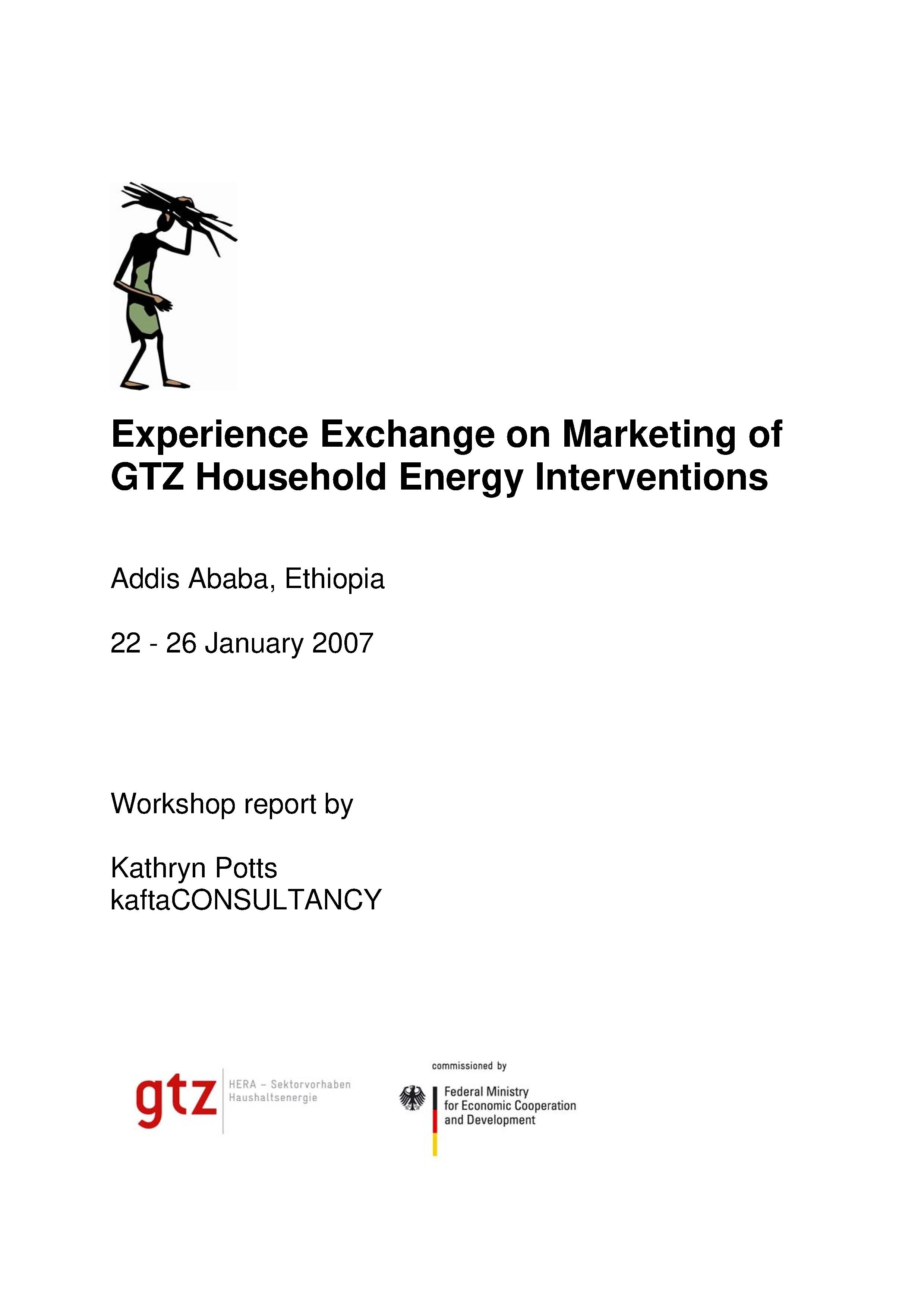
Report - Addis Ababa 22 – 26 Jan. 2007
The objective of this workshop was to discuss and analyse marketing strategies for stoves. Particular emphasis is given to aspects of marketing using the ‘4 Ps’. The workshop content focussed on the Ethiopian situation; however, various examples are from different GTZ projects in Africa and are applicable to many developing countries. Very helpful examples of price chains are explained.
The main marketing tools were divided into three subgroups:
- Experience tools: Lessons learnt
- Information tools: Selling slogans and repayment strategies
- Promotional tools: Public relations strategies
'Training Module for the Marketing of CHITEZO MBAULA – Malawi'
This short module is targeted at extension workers, stove producers and village authorities. It is useful as an introduction as it gives a condensed overview of the topic.
Commercialisation des Foyers Améliores
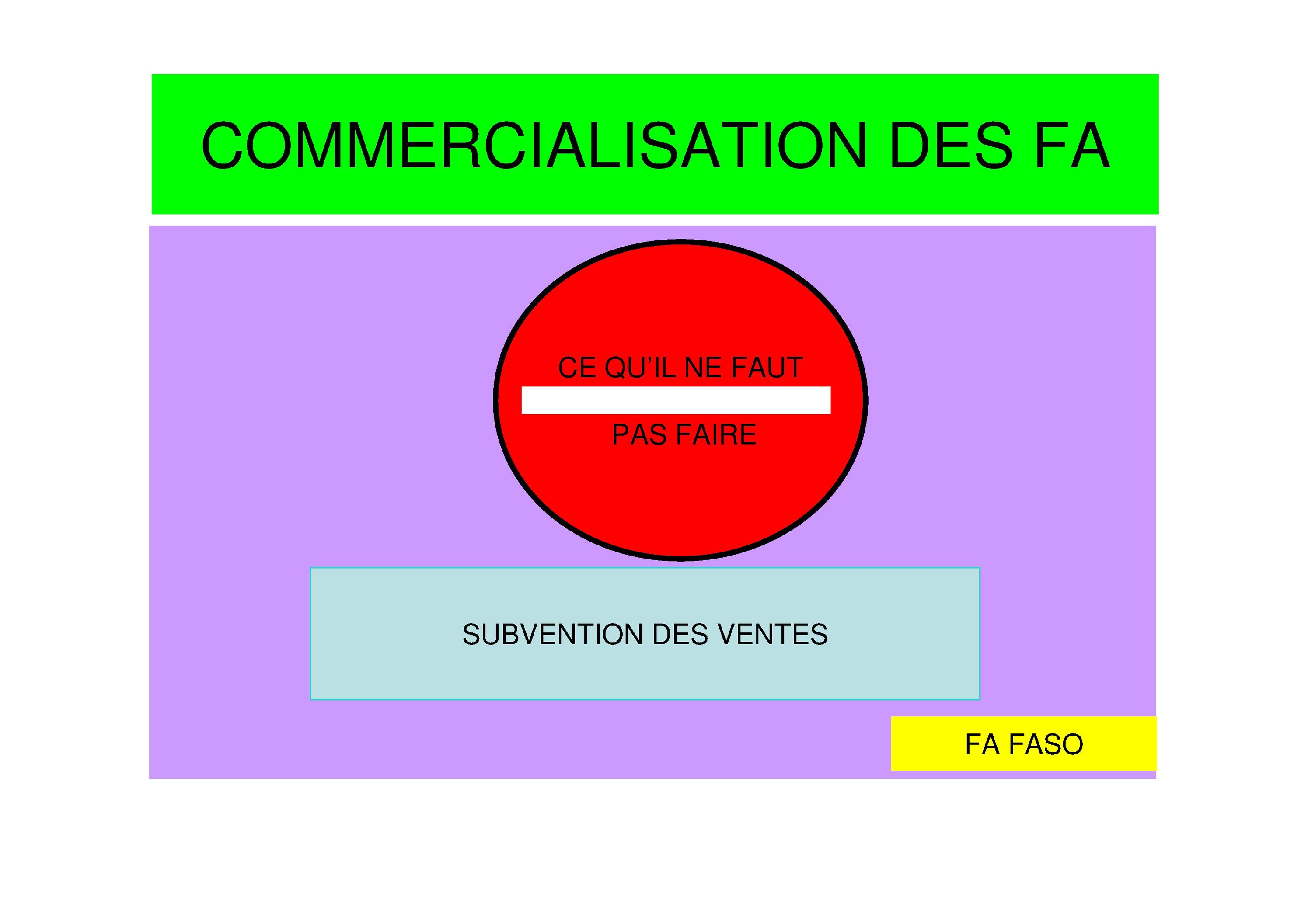
This is a condensed PowerPoint presentation on the main findings from a marketing study conducted by the FAFASO Project in Burkina Faso.
Curriculum component: solar energy/solar cooking for teacher training colleges in Afghanistan
Guideline developed by Barbara Clasen for GTZ/BEPA the Basic Education Project Afghanistan, June 2007.
The main purpose of this guideline is to enable teachers to tackle the topic of solar cooking in a didactic and methodologic way for any given group.
Top of the Page
--> Back to Overview GIZ HERA Cooking Energy Compendium

